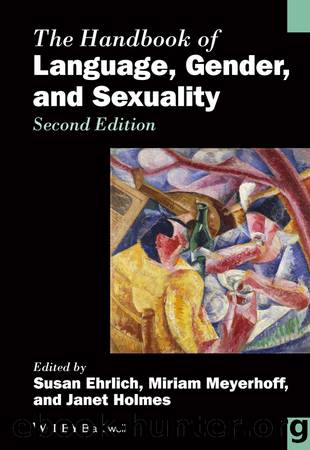Blackwell Handbooks in Linguistics by unknow

Author:unknow
Language: eng
Format: epub
Publisher: John Wiley & Sons, Incorporated
Published: 2014-05-19T00:00:00+00:00
2. Terminological Preliminaries
The rest of this chapter will develop and illustrate these ideas a bit more, but before talking about meaning-making specifically I will briefly sketch what I have in mind by gender, by sexuality, and by ideology. And along the way I will talk about other words in this area as well—for example, labels for what is called sexual orientation. In other words, I invite readers to engage with me in some preliminary meaning-making so we will be better able to engage with our topic.
Gender and sexuality are intimately intertwined. Cross-culturally, gender builds on (1) sexual categorization of people, with genital, chromosomal, and hormonal criteria sorting into female and male; (2) sexual encounters, especially potentially reproductive ones; (3) sexual reproduction, which creates infant humans; (4) subsequent rearing of the children produced. Gender involves the complex array of social arrangements and institutions, cultural practices and values, connected to these four matters, and gender varies greatly over time and space. Some cultures have wide-ranging divisions of labor for the sexes, some do not. Some strongly proscribe adolescent sexual activity, others promote it. We could continue with a long list of cross-cultural differences in gender.
Even the four apparently “biological” building blocks with which I begin show variation. Sexual categorization, for example, is not so straightforward or neatly dichotomizing as we often think. Our forebears could look at a baby's genitalia and (usually) thereby assign the baby to a sex class but they could not determine chromosomal makeup (which is not exhausted by the standard XX “female” and XY “male” patterns) or hormone levels. For one reason or another, some 1–2 percent of healthy babies fall outside the neat binary split into female and male. How cultures deal with such “recalcitrant” bodies varies. A recent movement in North America and elsewhere promotes acceptance of “intersex” people, not insisting on a strict sexual binarism. Note also that although a person may be assigned to one gender class quite readily at birth, they may not feel themselves to “belong” to that class. Gender identity as experienced internally may diverge from that ascribed by others, leading in some cases to sex reassignment in adulthood (or, in recent years, even earlier). Sex reassignment typically draws on technological developments such as hormone therapy to help produce a body that better fits the internally experienced gender identity than the body that developed without such interventions. Reproductive technologies have also changed the gender/sexual landscape. Only very recently, for example, did it become possible for an egg to be fertilized by a sperm without sexual contact between the individuals providing those resources, or for fertilization to occur in test tubes, or for a fertilized egg to be implanted in the uterus/womb of a different woman than the one from whom the egg came. Such new possibilities create a potential distinction between the gestational mother, the one whose body nurtures the developing fetus and finally gives birth to the resulting baby, and the genetic mother, the one whose body produced the egg. Or consider the nurturing of newborn infants and older children.
Download
This site does not store any files on its server. We only index and link to content provided by other sites. Please contact the content providers to delete copyright contents if any and email us, we'll remove relevant links or contents immediately.
Cecilia; Or, Memoirs of an Heiress — Volume 1 by Fanny Burney(32436)
Cecilia; Or, Memoirs of an Heiress — Volume 2 by Fanny Burney(31872)
Cecilia; Or, Memoirs of an Heiress — Volume 3 by Fanny Burney(31857)
The Lost Art of Listening by Michael P. Nichols(7409)
Asking the Right Questions: A Guide to Critical Thinking by M. Neil Browne & Stuart M. Keeley(5646)
We Need to Talk by Celeste Headlee(5545)
On Writing A Memoir of the Craft by Stephen King(4863)
Dialogue by Robert McKee(4323)
Pre-Suasion: A Revolutionary Way to Influence and Persuade by Robert Cialdini(4151)
I Have Something to Say: Mastering the Art of Public Speaking in an Age of Disconnection by John Bowe(3842)
Elements of Style 2017 by Richard De A'Morelli(3307)
The Book of Human Emotions by Tiffany Watt Smith(3238)
Fluent Forever: How to Learn Any Language Fast and Never Forget It by Gabriel Wyner(3031)
Name Book, The: Over 10,000 Names--Their Meanings, Origins, and Spiritual Significance by Astoria Dorothy(2940)
Good Humor, Bad Taste: A Sociology of the Joke by Kuipers Giselinde(2904)
Why I Write by George Orwell(2875)
The Art Of Deception by Kevin Mitnick(2736)
The Grammaring Guide to English Grammar with Exercises by Péter Simon(2711)
Ancient Worlds by Michael Scott(2626)
